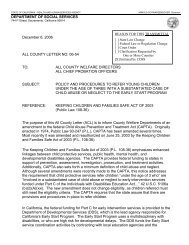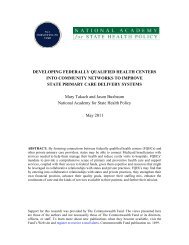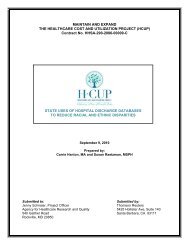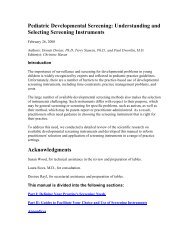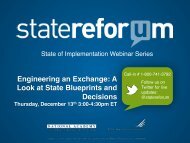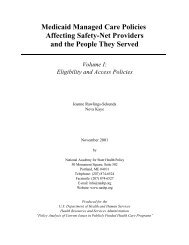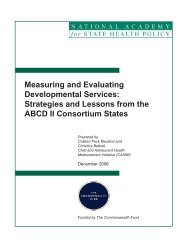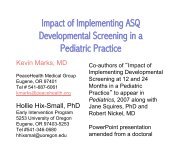Improving Care Coordination, Case Management, and Linkages to
Improving Care Coordination, Case Management, and Linkages to
Improving Care Coordination, Case Management, and Linkages to
You also want an ePaper? Increase the reach of your titles
YUMPU automatically turns print PDFs into web optimized ePapers that Google loves.
16<br />
State policies also determine the scope of benefits covered under CHIP. If CHIP is part of Medicaid, benefits<br />
must include EPSDT. If the state elects <strong>to</strong> use a separate CHIP plan, benefits may be more limited <strong>and</strong><br />
more family cost sharing may be required. The extent <strong>to</strong> which non-Medicaid CHIP plans cover CC/CM<br />
is limited. In a study of six of the 14 such State CHIP programs in operation in 2002, the majority limited<br />
(three states) or excluded (two states) CC/CM even for children with serious, complex conditions. 35<br />
States have opportunities for improvement in this area.<br />
ti tle v pro g r A m s<br />
The Title V Maternal <strong>and</strong> Child Health Services (MCH) Block Grant program provides grants <strong>to</strong> states <strong>to</strong>:<br />
•<br />
•<br />
assist state public health agencies in planning, promoting, coordinating, <strong>and</strong> evaluating service<br />
systems for pregnant women, mothers, infants, <strong>and</strong> children who do not have access <strong>to</strong> adequate<br />
health care; <strong>and</strong><br />
coordinate or provide health services <strong>to</strong> children with special health care needs (CSHCN) <strong>and</strong><br />
their families.<br />
Because the Title V funds are flexible, states can use them <strong>to</strong> support <strong>and</strong> fund infrastructure for linkages<br />
such as: interagency planning, child health databases, development of common definitions across programs,<br />
cross-sec<strong>to</strong>r professional training, family support projects, or quality improvement collaboratives.<br />
When EPSDT was enacted in 1967 “<strong>to</strong> discover, as early as possible, the ills that h<strong>and</strong>icap our children”<br />
<strong>and</strong> <strong>to</strong> provide “continuing follow up <strong>and</strong> treatment so that h<strong>and</strong>icaps do not go neglected,” both the<br />
Title XIX (Medicaid) <strong>and</strong> Title V (Maternal <strong>and</strong> Child Health) portions of the Social Security Act were<br />
amended. Thus, Medicaid <strong>and</strong> Title V both have legal duties <strong>to</strong> support EPSDT. Since the enactment of<br />
EPSDT, state Medicaid agencies—which tend <strong>to</strong> function as administrative <strong>and</strong> fiscal managers—have<br />
faced challenges in fulfilling their statu<strong>to</strong>ry obligations <strong>to</strong> provide outreach <strong>and</strong> information, as well as assistance<br />
with scheduling <strong>and</strong> transportation. Over the years, many Medicaid agencies have used state Title<br />
V programs <strong>to</strong> assist in these obligations. 36 One approach is <strong>to</strong> reimburse local health departments for<br />
time spent assisting families in the appropriate use of children’s health services under the EPSDT benefit.<br />
Activities might include reminder <strong>and</strong> recall activities such as telephone calls <strong>to</strong> reduce missed appointments<br />
<strong>and</strong> reconnect with families with children overdue for an EPSDT screening (well-child) visit. Local<br />
EPSDT coordina<strong>to</strong>rs (see below) often work out of local health departments. Title V collaborates with<br />
Medicaid in some states <strong>to</strong> finance other types of CC/CM. 37<br />
In the context of Title V, CSHCN are defined as: “Children who have, or are at increased risk for, chronic physical,<br />
developmental, behavioral, or emotional conditions <strong>and</strong> who also require health <strong>and</strong> related services of a type<br />
or amount beyond that required by children generally.” 38 Each state defines the categories of special needs<br />
children eligible for the programs <strong>and</strong> services for CSHCN. Typically, these categories include children<br />
with chronic illnesses, genetic conditions, <strong>and</strong> physical disabilities, but usually not those with social, emotional<br />
or mental health or developmental conditions. Moreover, the definition of CSHCN may be unique<br />
<strong>to</strong> the Title V program <strong>and</strong> not used by Medicaid, IDEA, mental health or other programs.<br />
Every state Title V program has both an MCH <strong>and</strong> a CSHCN unit, which receive both core <strong>and</strong> special<br />
grant initiative funding. A portion of overall funding is “set-aside” at the federal level for special projects<br />
<strong>and</strong> initiatives. The Title V MCH Block Grant funds are then allocated <strong>to</strong> the states based on a matching<br />
formula that requires a $3.00 state match for every $4.00 in federal funds. At least 30 percent of each<br />
state’s allocation must be spent on activities for CSHCN, <strong>and</strong> an additional 30 percent on primary health<br />
care for children. States vary greatly in the approaches they use in spending these. For Fiscal Year 2007,<br />
the reported share of spending ranged from 56/11 percent <strong>to</strong> 9/46 percent, respectively, with most<br />
<strong>Improving</strong> <strong>Care</strong> <strong>Coordination</strong>, <strong>Case</strong> <strong>Management</strong>, <strong>and</strong> <strong>Linkages</strong> <strong>to</strong> Service for Young Children: Opportunities for States<br />
National Academy for State Health Policy



